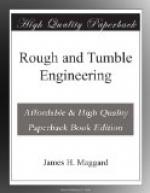We will take for example a steel boiler 32 inches in diameter and 6 ft. long, 3/8 in. thick, tensile strength 60,000 lbs. The total pressure required to burst this shell would be the area exposed times the pressure. The thickness multiplied by the length then by 2 (as there are two sides) then by the tensile strength equals the bursting pressure: 3/8 x 72 X 2 x 60,000 = 3,240,000 the total bursting pressure and the pressure per square inch required to burst the shell is found by dividing the total bursting pressure 3,240,000 pounds by the diameter times the length 3,240,000 / (32 x 72) = 1406 lbs.
It would require 1406 lbs. per square inch to burst this shell if it were solid, that is if it had no seam, a single seam affords 62 per cent of the strength of shell, 1406 x .62 = 871 lbs. to burst the seam if single riveted; add 20 per cent if double riveted.
To determine the safe working pressure divide the bursting pressure of the weakest place by the factor of safety. The United States Government use a factor of 6 for single riveted and add 20 per cent for double riveted, 871 / 6 = 145 lbs. the safe working pressure of this particular boiler, if single riveted and 145 + 20 per cent=174 double riveted.
Now suppose you take a boiler the same length and of the same material, but 80 inches in diameter. The bursting pressure would be 3,240,000 / (80 x 72) = 560 lbs., and the safe working pressure would be 560 / 6 = 93 lbs.
You will see by this that the diameter has much to do with the safe working pressure, also the diameter and different lengths makes a difference in working pressure.
Now all of this is nice for you to know, and it may start you on a higher course, it will not make you handle your engine any better, but it may convince you that there is something to learn.
Suppose we give you a little touch of rules, and formula in boiler making.
For instance you want to know the percent of strength of single riveted and double riveted as compared to solid iron. Some very simple rules, or formula, are applicable.
Find the percent of strength to the solid iron in a single-riveted seam, 1/4 inch plate, 5/8 inch rivet, pitched or spaced 2 inch centers. First reduce all to decimal form, as it simplifies the calculation; 1/4=.25 and 5/8 inch rivets will require 11/16 inch hole, this hole is supposed to be filled by the rivet, after driving, consequently this diameter is used in the calculation, 11/16 inches=.6875.
First find the percent of strength of the sheet.
P-D ----- The formula is P = percent.
P = the pitch, D = the diameter of the rivet hole, percent = percent of strength of the solid iron.




